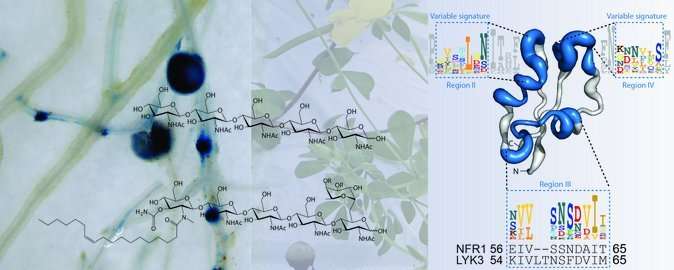Researchers discover how plants distinguish beneficial from harmful microbes

Legume plants know their friends from their enemies, and now we know how they do it at the molecular level. Plants recognize beneficial microbes and keep harmful ones out, which is important for healthy plants production and global food security. Scientists have now discovered how legumes use small, well-defined motifs in receptor proteins to read molecular signals produced by both pathogenic and symbiotic microbes. These remarkable findings have enabled the researchers to reprogram immune receptors into symbiotic receptors, which is the first milestone for engineering symbiotic nitrogen-fixing symbiosis into cereal crops.
Legume plants fix atmospheric nitrogen with the help of symbiotic bacteria, called Rhizobia, which colonize their roots. Therefore, plants have to be able to precisely recognize their symbiont to avoid infection by pathogenic microbes. To this end, legumes use different LysM receptor proteins located on the outer cell surface of their roots. In the study published in Science, an international team of researchers led by Aarhus University show that pathogenic (chitin) or symbiotic signaling molecules (Nod factors) are recognized by small molecular motifs on the receptors that direct the signaling output towards either antimicrobial defense or symbiosis.
All land plants have LysM receptors that ensure detection of various microbial signals, but how a plant decides to mount a symbiotic or an immune response towards an incoming microbe is unknown. "We started by asking a basic and, maybe at start, naïve question: Can we identify the important elements by using very similar receptors, but with opposing function as background for a systematic analysis?" says Zoltán Bozsoki. "The first crystal structure of a Nod factor receptor was a breakthrough. It gave us a better understanding of these receptors and guided our efforts to engineer them in plants." Kira Gysel adds.
The study combines the structure-assisted dissection of defined regions in LysM receptors for biochemical experiments and in planta functional analysis. "To really understand these receptors, we needed to work closely together and combine structural biology and biochemistry with the systematic functional tests in plants," says Simon Boje Hansen. By using this approach, the researchers identified previously unknown motifs in the LysM1 domain of chitin and Nod factor receptors as determinants for immunity and symbiosis. "It turns out that there are only very few, but important, residues that separate an immune from a symbiotic receptor and we now identified these and demonstrate for the first time that it is possible to reprogram LysM receptors by changing these residues," says Kasper Røjkjær Andersen.
The long-term goal is to transfer the unique nitrogen-fixing ability that legume plants have into cereal plants to limit the need for polluting commercial nitrogen fertilizers and to benefit and empower the poorest people on Earth. Simona Radutoiu concludes, "We now provide the conceptual understanding required for a stepwise and rational engineering of LysM receptors, which is an essential first step towards this ambitious goal."
More information: Zoltan Bozsoki et al. Ligand-recognizing motifs in plant LysM receptors are major determinants of specificity. Science 07 Aug 2020: Vol. 369, Issue 6504, pp. 663-670 DOI: 10.1126/science.abb3377
Journal information: Science
Provided by Aarhus University




















